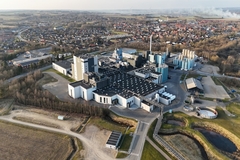
- Industry news
Industry news
- Category news
Category news
- Reports
- Key trends
- Multimedia
- Journal
- Events
- Suppliers
- Home
- Industry news
Industry news
- Category news
Category news
- Reports
- Key trends
- Multimedia
- Events
- Suppliers
Cheese caves: Scientists monitor mold color for flavor innovation opportunities

Scientists in the US have examined how the fungi on cheese evolve in response to the environment through a study of mold on Bayley Hazen Blue cheese. The findings could provide opportunities for manufacturers to develop new cheese varieties and control fungal growth in food production.
The cheese changed its color from green to white over a few years in a cave, where it was stored to mimic traditional aging processes for enhanced ripening and flavor development. The color change occurred due to a mutation in a gene called alb1 in the fungus Penicillium solitum, commonly found on cheese rinds.
Alb1 produces melanin, a pigment that protects organisms from UV damage and imparts the fungi’s green color. Since the fungi did not need melanin inside the dark cave, it adapted to become white over time through a process called “relaxed selection,” leading to the cheese becoming white instead of green.

The research was led by Dr. Benjamin Wolfe from Tufts University, who observed the evolution of mold on the cheese rinds over several years within the Jasper Hill Farm in Vermont’s cheese caves — a naturally humid and cool environment ideal for cheese aging.
“My lab has been using cheese rinds for over a decade as a microbial ecology model system. These simple food communities provide ample opportunities to understand how microbial communities form and function,” Wolfe tells Food Ingredients First.
“These findings are useful for managing microbes in food production. They can also teach us general principles that can extend to a range of microbial systems, from the human microbiome to soils.”
Studying cheese evolution
The study, published in Current Biology, explored an opportunity to identify the genetic mechanisms that led to a “small evolutionary change,” note the scientists.
 The mold on the rind of Bayley Hazen Blue cheese: The original green (left) and the evolved white several years later (Image credit: Benjamin Wolfe).“I’ve always wanted to be able to study the evolution of cheese rind fungi. But it requires certain conditions and settings. Cheese caves are perfect for studying fungal evolution. Fungi live in these environments for many generations as they repeatedly colonize the cheese surface,” says Wolfe.
The mold on the rind of Bayley Hazen Blue cheese: The original green (left) and the evolved white several years later (Image credit: Benjamin Wolfe).“I’ve always wanted to be able to study the evolution of cheese rind fungi. But it requires certain conditions and settings. Cheese caves are perfect for studying fungal evolution. Fungi live in these environments for many generations as they repeatedly colonize the cheese surface,” says Wolfe.
“We have an amazing history of collaboration with Jasper Hill Farm in Vermont, where we have been observing their cheeses for many years. The combination of temporal samples over many years and careful observations by their team and ours allowed us to identify this unique example of fungal evolution.”
Meanwhile, co-author graduate student Nicolas Louw says understanding how fungi adapt to different environments can also help improve food security and health.
“Somewhere around 20% of staple crops are lost pre-harvest due to fungal rot, and an additional 20% are lost to fungi post-harvest, including the moldy bread in your pantry and rotting fruit on market shelves. The biggest threat to global food security is just rot from mold.”
Tracking “jumping genes”
The team faced challenges during the study in tracking the genetic changes in the fungi’s genome.
“One of the most common causes of the genetic changes in the fungal genome was a transposable element. These are “jumping genes” that can pop out of one part of a genome and then insert into other parts of a genome,” explains Wolfe.
 Understanding how fungi adapt to different environments can help advance food security and health.“These can be relatively hard to track, and their insertions can be hard to detect. It took quite a bit of detective work by PhD student Nicolas Louw and myself to determine this exact mechanism of evolution.”
Understanding how fungi adapt to different environments can help advance food security and health.“These can be relatively hard to track, and their insertions can be hard to detect. It took quite a bit of detective work by PhD student Nicolas Louw and myself to determine this exact mechanism of evolution.”
While some fungi had point mutations — single DNA base pair changes — at different locations in the genome, others had a large insertion of DNA caused by the transposable element, notes the study.
Advancing cheese innovation
The team is now exploring the fungi’s gene mutation to develop new cheese varieties with better aesthetics, taste, and texture. For example, the team inoculated fresh brie cheese with the novel white mold discovered in this study, which, according to the scientists, led to a “nuttier and less funky” taste.
“By understanding how new strains of fungi can evolve in food production environments, it can point to how we might create new genetic diversity in fungal food production systems. This may allow us to add new aesthetics and flavors to cheeses and other fermented foods,” Wolfe concludes.










